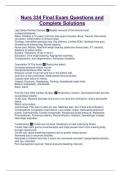Nurs 334 Final Exam Questions and
Complete Solutions
Leg Calves Perthes Disease ✅Aseptic necrosis of the femoral head
(unilateral/bilateral).
Risks: Children 2-12 years, Common kids ages 4-8 years, Boys, Trauma, Decreased
circulation, Inflammation to femoral head.
Findings: Intermittent painless limp, Hip stiffness, Limited ROM, Hip/thigh/knee pain,
Shortening of affected leg, Muscle wasting.
Nurse care: Nsaids, Rest/limit weight bearing (abduction brace/casts, PT, traction),
Advance to active motion.
Surgery: Osteotomy of hip or femur.
Education: Limit weight bearing, Appropriate activities.
Complications: Joint degeneration, Permanent disability.
Coarctation Of The Aorta ✅Obstructive defect.
Increased pressure before narrow.
Decreased pressure after narrow.
Pressure is high in top half and low in the bottom half.
Cool skin at low extremities; Weak/absent femoral pulses.
Causes heart failure in infants.
Causes: Dizziness, Headaches, Fainting, Nosebleeds (older kids).
Balloon angioplasty- infants/kids.
Stent- teens.
Post Op Care After Cardiac Surgery ✅Respiratory: Suction, Decreased breath sounds,
Cough/deep breathe.
Chest tube: Measure drainage every hour (no more than 3ml/kg/hr)- drains pericardial
space.
Watch urine output.
Comfort/rest: Plan care to allow for rest, Medicate pain, Out of bed and ambulation.
Complications: Congestive heart failure, Low cardiac output, Decreased peripheral
pulses, Dysrhythmias, Cardiac tamponade, Paradoxical pulse pressure, Atelectosis,
Pneumothorax, Pulmonary edema, Pleural effusion, Infection, Hematologic change,
Neurologic sequelae.
Tonsilectomy ✅Tonsils are removed. Necessary to treat underlying illness.
Tonsils help catch germs (virus/bacteria) and helps prevent them from entering body
through nose/mouth.
Tonsils can cause breathing problems due to growth (sleep apnea).
Removed due to recurrent tonsillitis.
Removed in children less than 2 years old, monitored overnight- airway/bleed/hydration
post op= important.
Pain management post op: Tylenol prevents bleeding, Narcotic.
,Post op teaching: Limit activity, Liquids, No straw for 2 weeks, Soft foods for 10-14 days
to decrease pain, Clean mouth, Frequent swallowing indicates bleeding.
Cystic Fibrosis ✅Exocrine glands.
Autosomal recessive.
25% chance with each pregnancy.
Sticky mucus builds up in lungs/pancreas/gi system.
Pancreatic insufficiency: Digestive enzymes can't enter small intestine, Food can't be
broken down properly, Nutrients aren't absorbed.
Results: Poor weight gain, Poor growth, Poor absorption (sluggish, anemia), Poor fat
absorption, Salty sweat, Constant cough/wheeze, Thick mucus/phlegm, Lung/sinus
infections, Greasy/smelly stools, Polyps in the nose.
Treatment: Keep lungs clear of thick mucus, Lung transplant (not cure).
Diet: Vitamins D, A, K, E; high calorie; High fluid; Chest pt; Thairapy vest.
Medications: Bronchodilator, Mucus thinners, Tobramycin.
Sudden Infant Death Syndrome ✅(SIDS).
Offer pacifier at nap time/bed time.
Don't smoke, Drink alcohol, Or use drugs.
Stay away from smoker and places where people smoke.
Hold newborn skin-skin while breastfeeding.
Breastfeed as soon as possible after birth.
Have baby sleep on back on firm sleep surface.
Keep soft objects, loose beding, objects that could increase risk of
entrapment/suffocation/strangulation out of crib.
Keep baby in same room to sleep.
Breastfeed as long as possible.
Schedule/attend all well child visits.
Don't allow baby to get too hot.
Vesicoureteral Reflux ✅(VUR).
Retrograde flow of urine from bladder into ureters.
Management: May resolve on own, Low dose antimicrobials, Surgery.
Begin to get reflux- back flow into ureter and possibly into kidneys-should have
sphincter to prevent urine back flow into ureter.
Bladder scan.
Treatment: Medication (long term) to keep it functioning if ureter is salvageable- stent,
Unsalvageable- kidney/ureter transplant.
Adolescent Dangers ✅Relationships begin outside of the home.
Narcissistic value system.
At risk for drowning related to 3D's: Drinking, Drugs, Dares.
Leading cause of death- MVCs.
Alcohol involved in injuries.
Mvc, Suicide, Homicide.
Suicide high risk for LGBTQI.
, Difference in suicide methods/outcomes in males/females.
Behaviors of suicide: Typical or atypical symptoms of depression, Psychosomatic
complaints, Behavior problems, Well thought out plan.
School Aged Dangers ✅Out of the house with peers now.
More exposure to more environments.
Booster seat until 4'9" or age 12 years.
Make sure seat belt restraints fit properly.
Greatest time of injury is after school and before bedtime.
Peer pressure contributes to risk taking behaviors.
Ride bikes with traffic, walk against traffic.
Check helmet for 4S's- Sticker, Size, Strap, Sits even.
Safety equipment worn when playing sports.
Preschool Dangers ✅Improved gross/fine motor control.
Less prone to falls than toddlers.
Out of adults vision more often.
Less at risk for airway issues with putting things in their mouths.
Good time to start teaching about safety but don't expect them to apply teachings.
Toddler Dangers ✅Scald burns, Electrical socket burns, Stove top burns, Sun burns.
Dog attacks.
Resist confinement.
Leading cause of accidental death ages 1-4= drowning.
Pool fence on all 4 sides, 5 feet high.
Take fun, enticing items out of the pool.
Unrestricted freedom through locomotion combined with an unawareness of danger
within environment.
Don't understand cause/effect, unable to gauge danger, poorly defined depth
perception, bodily structure.
Infant Dangers ✅Can drown in 1 inch of water (bucket).
Top heavy, Big heads, Different center of gravity.
Explore by putting things in their mouths/airways.
Middle of back seat, Rear facing until 24 moths.
Scald burns are most common burns.
3 leading causes of accidental death/injury in infants include: Suffocation, Mvc,
Drowning.
Falls are leading cause of nonfatal injury.
Crib slats should be 6 cm apart.
Aspirin Overdose ✅Acute poison (early) signs: Nausea, Hyperventilation, Vomiting,
Tinnitus.
Acute poison (late) signs: Hyperactivity, Fever, Confusion, Seizures, Renal failure,
Respiratory failure.




